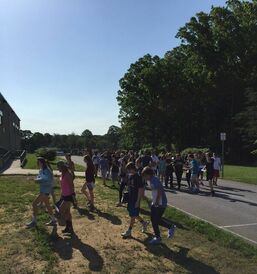Systemic Sustainability: 1.2 Professional Development
2018
 Inspired by the theme of "Take It Outside", 8th grade language arts teachers return from outside with their students after spending a language arts lesson about setting and imagery outdoors.
Inspired by the theme of "Take It Outside", 8th grade language arts teachers return from outside with their students after spending a language arts lesson about setting and imagery outdoors.
2018: Take It Outside
The theme of this year’s staff wide green school professional development was outdoor education. Studies show that simply being outside increases one’s appreciation for the environment. Familiarity, appreciation, and respect are needed to ultimately develop stewardship.
Piggybacking on a presentation by SPMS parent and Chesapeake Bay Foundation Director of Teacher Training, Tom Ackerman, Green School Liaisons Mike Philip and Jen Shelleman provided materials to inspire teachers to expand their classrooms, and the impactful nature of learning, by taking students outside. The message was aimed at conveying the point that the outside is easily accessible and that incorporating this practice into everyday curriculum objectives is simple and straightforward. Additionally, outdoor learning is not relegated to science and lab activities. Outside lessons can be applied across all curriculum. While being green and environmentally-minded may be rooted in science, its reach is much farther and deeper than that; it is a mindset and a life practice.
The information provided prompted teachers who are already engaged in this strategy to share their successes, with the hope of inspiring others to do the same. Long term strategies for the multiple courtyards were discussed, including how they might be enhanced to be more conducive to conducting classroom lessons. Ideas developed, such as themes for each courtyard; one for math, another for language arts, and another for math or science. It was suggested that the art department create lessons having students create outdoor art to adorn the courtyards and contribute to the themes. Departments were challenged to develop suggestions for the future of the courtyards. The idea of engaging prospective Eagle Scouts to make future plans a reality was all part of this inspiring discussion. While development of the courtyards was projected as a long-term SPMS Green School Program goal, encouraging the practice of heading outdoors for learning was the immediate purpose.
This professional development also strove to illustrate the point that the green school program is available to all and does not have to address every environmental component in order to be beneficial and meaningful. Introducing elements and exposing students to the natural world, even a little at a time, adds up over time to cultural awareness and change. To do this, all the staff members were challenged to play a green school version of Jeopardy. The staff had fun showing their expertise or gaining knowledge. Each correct or revealed answer led to more related information being shared to further the point. In the spirit of friendly competition, environmental prizes were even awarded, including re-usable water bottles and coffee cups; constant reminders of this training and the SPMS green school program.
The theme of this year’s staff wide green school professional development was outdoor education. Studies show that simply being outside increases one’s appreciation for the environment. Familiarity, appreciation, and respect are needed to ultimately develop stewardship.
Piggybacking on a presentation by SPMS parent and Chesapeake Bay Foundation Director of Teacher Training, Tom Ackerman, Green School Liaisons Mike Philip and Jen Shelleman provided materials to inspire teachers to expand their classrooms, and the impactful nature of learning, by taking students outside. The message was aimed at conveying the point that the outside is easily accessible and that incorporating this practice into everyday curriculum objectives is simple and straightforward. Additionally, outdoor learning is not relegated to science and lab activities. Outside lessons can be applied across all curriculum. While being green and environmentally-minded may be rooted in science, its reach is much farther and deeper than that; it is a mindset and a life practice.
The information provided prompted teachers who are already engaged in this strategy to share their successes, with the hope of inspiring others to do the same. Long term strategies for the multiple courtyards were discussed, including how they might be enhanced to be more conducive to conducting classroom lessons. Ideas developed, such as themes for each courtyard; one for math, another for language arts, and another for math or science. It was suggested that the art department create lessons having students create outdoor art to adorn the courtyards and contribute to the themes. Departments were challenged to develop suggestions for the future of the courtyards. The idea of engaging prospective Eagle Scouts to make future plans a reality was all part of this inspiring discussion. While development of the courtyards was projected as a long-term SPMS Green School Program goal, encouraging the practice of heading outdoors for learning was the immediate purpose.
This professional development also strove to illustrate the point that the green school program is available to all and does not have to address every environmental component in order to be beneficial and meaningful. Introducing elements and exposing students to the natural world, even a little at a time, adds up over time to cultural awareness and change. To do this, all the staff members were challenged to play a green school version of Jeopardy. The staff had fun showing their expertise or gaining knowledge. Each correct or revealed answer led to more related information being shared to further the point. In the spirit of friendly competition, environmental prizes were even awarded, including re-usable water bottles and coffee cups; constant reminders of this training and the SPMS green school program.

